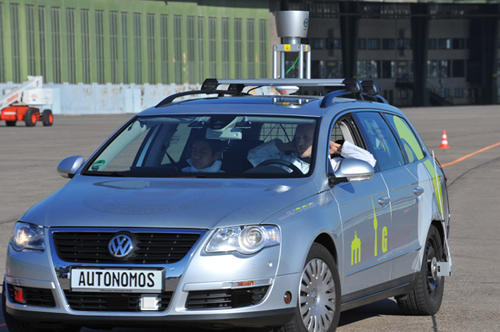A Car That Thinks for Itself
Autonomous Car Detects Traffic Lights and Navigates Safely in Dangerous Situations
№ 310/2010 from Oct 15, 2010
Scientists at Freie Universität Berlin have developed an autonomous vehicle equipped with advanced sensor technology that can navigate independently in traffic. They envision that in the long term driverless cars will be part of everyday traffic.
The car dubbed MadeInGermany is able to detect other cars, motorcycles, bicycles, and pedestrians and thus cope safely with complex traffic situations. It can recognize traffic lights, stop signs, the trace lines on the road, etc., and it “knows” how to implement the traffic rules including right-of-way. Three video cameras, multiple laser scanners, and radar allow the onboard computer to calculate a three-dimensional model of the road and assess the traffic situation. The car can be controlled using mobile devices such as an iPad.
The Berlin vehicle was developed by the robotics experts in the AutoNOMOS laboratory of Freie Universität Berlin under the direction of the computer science professor Raúl Rojas. The AutoNOMOS project aims to examine new forms of mobility and has been funded by the German Ministry for Education and Research within the ForMaT (Research for the Market in Teams) program since 2009. In a virtual innovation laboratory (InnoLab), specific concepts for autonomous vehicles and driver assistance programs are developed with a focus on market and customer demands.
With the long-term vision of building driverless cars with innovative environmentally friendly engine technologies and integrating them in regular traffic as “green vehicles,” the researchers at Freie Universität are assuming there will be new forms of interaction between humans and machines. In this scenario, passengers are picked up automatically after placing calls from mobile devices. The autonomous taxi from Berlin reports its position, and passengers can see the route of the approaching vehicle and the estimated waiting time on their screens. All the sensors and the commands for the vehicle can be accessed and transmitted via portable devices.
“Autonomous vehicles could make car sharing a reality by picking up passengers outside their front door, taking them to the workplace, and then continuing on with more passengers,” said Professor Raúl Rojas. In this way car traffic could be perfectly combined with bus and rail transportation. According to Rojas, “By exploiting an optimal combination of these technologies, a city such as Berlin would probably require only one fifth of the cars that are on the road today.”
The researchers from Freie Universität Berlin have been developing autonomous vehicles since 2006. The Spirit of Berlin, a converted Dodge Caravan, was a contestant in the 2007 DARPA Urban Challenge race for autonomous vehicles in California.
Further Information
- Prof. Dr. Raúl Rojas, Head of the Artificial Intelligence Group, Institute of Computer Science, Freie Universität Berlin, Email: rojas@inf.fu-berlin.de
- Tinosch Ganjineh, Head of the AutoNOMOS Project (Autonomous Cars and Driver Assistance Systems for Cars and Trucks), Tel.: +49 (0)30 / 838-75128; Email: ganjineh@inf.fu-berlin.de

